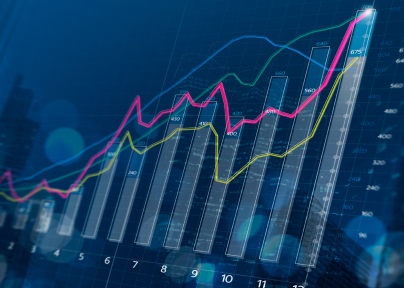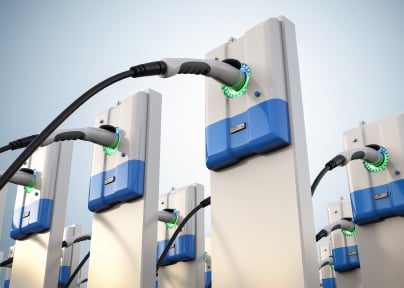For many organizations, managing energy is still perceived as simply a cost of doing business. As energy has become a global commodity, however, the markets have become increasingly volatile, with prices fluctuating wildly in the last 2 years. The current cost of keeping your business running paired with the likelihood of future volatility has greatly increased the importance of a more active approach to managing your energy usage.
WHY BUSINESSES NEED TO THINK LONG-TERM
Near-term market conditions are typically the most volatile and hardest to predict with any certainty. Prices fluctuate based on supply and demand conditions due to weather, infrastructure issues, production outages, and unforeseen economic conditions.
If you're responsible for your business's energy decisions, you may be wondering if the best strategy is to wait it out for prices to drop or to renew your contract before commodity prices rise higher. In a volatile market, your business is likely to benefit most from a proactive approach. In fact, businesses should consider their options long before an energy contract is up for renewal.
Historically, consumers could lock in their prices for the year in September — and do the same the following year. But with so many volatility factors in play, it's important to take a longer-term approach. This means looking out 3 to 5 years when making your energy contract decisions.

MANAGING RISK
Risk management is increasingly important, as our evolving energy landscape creates a market structure with higher highs and lower lows.
Before signing a contract, select a product from an energy supplier that aligns with your business's risk appetite and sensitivity to price fluctuations.
A time-of-use product directly passes on wholesale prices to consumers. When choosing this type of product, it’s important to understand how the energy market has been developed — and the fundamentals that affect these rates. (In deregulated energy markets, an hourly energy auction takes place, during which generators bid to participate. Rates are affected by demand for generation — typically driven by weather — generators’ efficiency, and the cost of fuel.) Power markets can be volatile, so it’s important to continuously monitor market conditions and make adjustments as necessary to stay ahead of changes.
A fixed energy price contract helps offset the hourly variability in energy prices. If your business is more risk-averse, your energy supplier can help manage that risk with this type of product — but it’s important to work with a supplier who has experience managing this risk.

COMMON APPROACHES TO BUYING ENERGY
There are two common strategies businesses use to buy their energy: a fixed-price, point-in-time strategy and a flexible buying strategy. When analyzing strategies for your business, it’s important to consider whether you want to lock in the various cost components or ride the market. In other words, you need to decide if you want to fix, float, or choose a combination of the two.
Which approach is best for managing long-term price risk? That depends on your organization’s goals.
THE FIXED-PRICED STRATEGY
This strategy is best for organizations who are seeking a stable bill each month. This may be suitable for businesses with a low risk tolerance, seek budget certainty, or don’t want to take an active role in managing your day-to-day energy costs.
With this approach, you’re choosing cost certainty by locking in several years’ worth of energy at the current price for the length of your contract. If you make your purchase when rates are low, you'll benefit from that lower rate for your entire term.
By choosing to fix cost components, you are locking into a set rate per kilowatt-hour (kWh) for electricity, or per CCF/MCF/Therm/Dekatherm for natural gas.
Your monthly bill still varies — based on your consumption — but the rate you pay stays constant regardless of what happens in the market.
Keep in mind that timing is everything. You want to lock in when rates are low and flat or falling for the period you’re considering. Long-term price certainty may come with a price premium.

THE FLEXIBLE STRATEGY
Often also referred to as a variable approach, this strategy requires you (and your energy supplier) to make multiple purchases over time. Doing so offers you the flexibility to respond in real time to market conditions.
Unlike a fixed strategy, a variable strategy is one in which pricing is tied to market rates — and is therefore changing constantly based on supply and demand. Your monthly bill varies based on both your consumption and the market rate. Because of the constant fluctuations, it’s likely your bill will look different from month to month, even if you consume the exact same amount of energy.
This strategy is beneficial if you want to take an active role in the management of your organization’s energy. By actively watching the market, the variable rate can help you take advantage of market volatility.
This may be suitable for your business if you have a higher risk appetite, can be nimble in adjusting your usage according to market conditions, and have a clear understanding of the energy market. If a spike in energy prices presents a significant risk to your business, this plan may not be right for you.
Businesses using a variable strategy often sign a contract but have the option to lock in a fixed price at any time.

A HYBRID APPROACH
Another option is a combination strategy that combines elements of fixed pricing with variable pricing under one contract. You can customize a plan for your business by fixing some components while floating others.
Some suppliers may allow you to buy a block of your energy at a fixed price, while usage that exceeds your designated usage is billed at the market price. You have access to wholesale market pricing and the option to fix or float as much of your energy as you choose, based on your risk tolerance and business goals.
Regardless of your approach, work with a supplier that will treat you as a partner in the process and lead with transparency. Ultimately, you want a strategy that is customized to your business, your goals, and your tolerance for risk.
12 QUESTIONS TO ASK YOUR ENERGY PARTNER
Crafting an effective energy strategy starts with partnering with an energy expert who can help organizations answer the following questions:



IN THIS REPORT, WE HIGHLIGHT THE KEY TRENDS AND TOPICS MOST AFFECTING THE ENERGY INDUSTRY — AND CONSUMERS.
Dive into the next section below.




